
 |
Tea Clipper |
 |
| from TeaAntiques.com | ||
| Edition One Hundred and One |
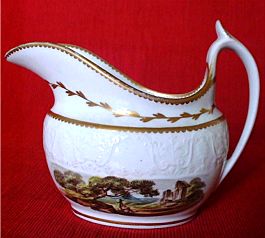
 An
attractive oval Spode creamer with a hand painted landscape on both sides with rural
figural and castle scenes, c1810.
An
attractive oval Spode creamer with a hand painted landscape on both sides with rural
figural and castle scenes, c1810.
The oval body is beautifully shaped with an elegant pouring lip and perfectly balanced loop handle. The body has applied moulded decoration around the upper portion of its body. This moulded decoration in the form of foliate swags. Below the moulded border are exquisite hand painted scenes on each side of the creamer jug. The scene on the left hand side of the jug is of a gentleman sat upon a rock under the shade of a shapely tree. He is gazing out towards a ruined castle or abbey building in a rolling landscape of hills and trees. It is a most charming scene that is beautifully painted in full colour. The right hand side of the creamer jug is painted with a similar scene, but this time it shows a stunning English landscape that is rocky with hills, trees and in the middle distance a castle. The colours and perspective of these paintings is very fine indeed.
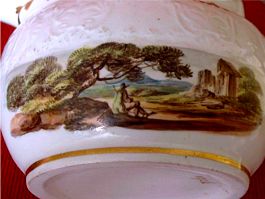
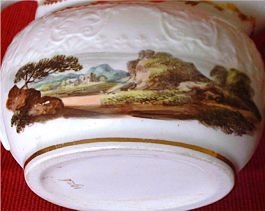
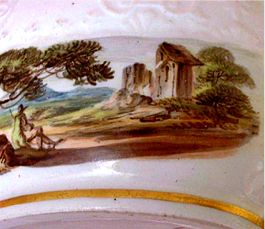
The base of the creamer jug is painted with the pattern number 1926 in gilt numerals. A fine antique creamer jug for the collector of early English porcelain.
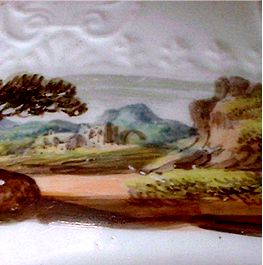
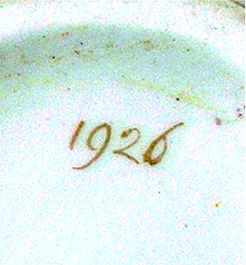
More details of this item and other tea related antiques can be found by visiting my web site at www.TeaAntiques.com.
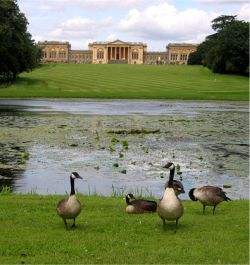
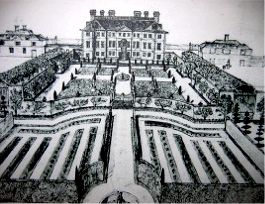 In
the previous 'Tea Clipper' I took you on a tour of Stowe House, now a public school.
This month, as promised, I will take you on a tour of the world famous Stowe Landscape
Gardens. These gardens have evolved over a period of nearly 300 years. When the
house was the early red brick house of the late 17th century, which Sir Richard
Temple bought in the early 1700, the gardens were laid out in a very formal way.
This formal style of garden was in vogue across Europe and comprised geometrically
laid out gardens with lots of trimmed trees and hedges, formal colourful flower
beds and regular shaped water features. Such gardens were extremely labour intensive
to maintain and showed the control that the owners had over nature. The garden that
Sir Richard Temple had designed included all the formal trappings, with temples,
walks and statutes. This formal style of gardens went out of fashion later in the
Eighteenth century in favour of the naturalistic landscape garden, made famous by
'Capability' Brown. Formal flower beds and trimmed hedges were swept away, landscapes
remodelled with rolling hills, informal lakes and shrubberies. Also, important in
such landscapes were temples, focal points and vistas. The gardens that we see today
were started by Sir Richard Temple in 1700's, but have been remodelled during the
Eighteenth century to this magnificent Landscape, but retaining many of the original
Temples from the earlier formal garden. At its peak, the garden boasted over 60
garden architectural features. Today, after many were sold, there still remains
over 30 of them.
In
the previous 'Tea Clipper' I took you on a tour of Stowe House, now a public school.
This month, as promised, I will take you on a tour of the world famous Stowe Landscape
Gardens. These gardens have evolved over a period of nearly 300 years. When the
house was the early red brick house of the late 17th century, which Sir Richard
Temple bought in the early 1700, the gardens were laid out in a very formal way.
This formal style of garden was in vogue across Europe and comprised geometrically
laid out gardens with lots of trimmed trees and hedges, formal colourful flower
beds and regular shaped water features. Such gardens were extremely labour intensive
to maintain and showed the control that the owners had over nature. The garden that
Sir Richard Temple had designed included all the formal trappings, with temples,
walks and statutes. This formal style of gardens went out of fashion later in the
Eighteenth century in favour of the naturalistic landscape garden, made famous by
'Capability' Brown. Formal flower beds and trimmed hedges were swept away, landscapes
remodelled with rolling hills, informal lakes and shrubberies. Also, important in
such landscapes were temples, focal points and vistas. The gardens that we see today
were started by Sir Richard Temple in 1700's, but have been remodelled during the
Eighteenth century to this magnificent Landscape, but retaining many of the original
Temples from the earlier formal garden. At its peak, the garden boasted over 60
garden architectural features. Today, after many were sold, there still remains
over 30 of them.

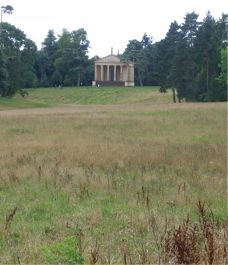 The
family that created Stowe's Landscape Gardens were Eighteenth century Whigs, descendants
of men who opposed the absolute rule of the Stuart Monarchy which culminated in
a revolution in 1688. It was the Whigs claim that they had established constitutional
monarchy and political freedom in England and saw themselves as the defender of
liberty. These political beliefs were maintained throughout the Eighteenth century
and were cleverly displayed in the architecture of the temples and statues around
the garden. Sir Richard Temple had statues within the landscape of the Hanoverian
monarchy, including a statue of King George I and then later Prince and Princess
of Wales (King George II and Queen Caroline). The statue of Queen Caroline was strategically
placed facing a statue of the goddess Venus, so that they appeared to gaze at each
other as equals.
The
family that created Stowe's Landscape Gardens were Eighteenth century Whigs, descendants
of men who opposed the absolute rule of the Stuart Monarchy which culminated in
a revolution in 1688. It was the Whigs claim that they had established constitutional
monarchy and political freedom in England and saw themselves as the defender of
liberty. These political beliefs were maintained throughout the Eighteenth century
and were cleverly displayed in the architecture of the temples and statues around
the garden. Sir Richard Temple had statues within the landscape of the Hanoverian
monarchy, including a statue of King George I and then later Prince and Princess
of Wales (King George II and Queen Caroline). The statue of Queen Caroline was strategically
placed facing a statue of the goddess Venus, so that they appeared to gaze at each
other as equals.
There are several routes given for visitor to follow, which vary in length and take in different walks and temples. I decided to do the gardens in two parts. The first took me round the extremities and the second round much of the gardens that I had encircled with the first walk. My tour began at the Temple of Concord and Victory. This first temple is impressive in both its relatively large scale and perfect architectural design. It is not really what one would expect to see in and English Landscape. This is the largest and grandest of the Stowe temples, the architect is unknown. It was begun in 1747 with the roof being added in 1749. It was initially known as the 'Grecian Temple' and is sited high up at one end of a long Valley called the Grecian Valley. The Temple is not a copy of any known Grecian temple, but a conglomeration of various architectural elements amalgamated to produce this elegant temple.
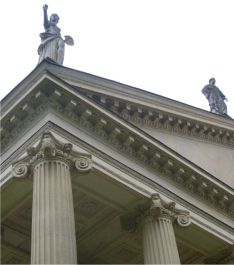
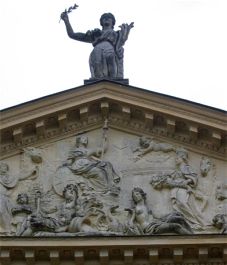
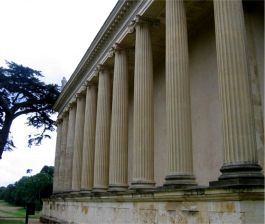
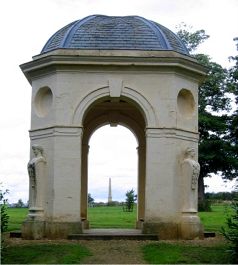
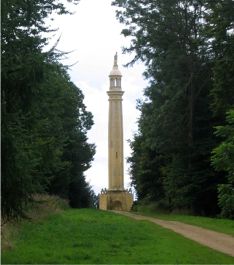 Making
my way along the side of the Grecian Valley, the next feature I came across was
'The Fane of Pastoral Poetry', earlier known simply as 'Gibb's building'. This small
open sided belvedere was designed for Lord Cobham by Gibbs in 1729 as part of the
Western phase of the garden remodelling. It originally stood on a mound below which
was an ice house. Earl Temple had it moved in the 1760's to this position to frame
a view of Wolfe's obelisk which he had erected outside the gardens to the north.
Making
my way along the side of the Grecian Valley, the next feature I came across was
'The Fane of Pastoral Poetry', earlier known simply as 'Gibb's building'. This small
open sided belvedere was designed for Lord Cobham by Gibbs in 1729 as part of the
Western phase of the garden remodelling. It originally stood on a mound below which
was an ice house. Earl Temple had it moved in the 1760's to this position to frame
a view of Wolfe's obelisk which he had erected outside the gardens to the north.
Swinging round to the South I walked along 'Lord Cobham's walk' with a vista of Lord Cobham's Pillar in the distance. This is the tallest of the Stowe monuments at 104 feet. It was built by Lady Cobham in honour of her husband Lord Cobham 1747-9 and was built in the last two years of his life. The Pillar is surmounted with a statue of Lord Cobham in Roman armour. The viewing lantern at the top is reached by an internal spiral staircase. From this viewing platform you are able to see five counties, sadly visitors to the gardens are not allowed up to enjoy this view. In 1750, 'Capability' Brown said that 'The wind has a very great effect on Buildings that stand on so small a base'. Thus in 1792, the four corner stone buttresses were added, these surmounted with Coade stone rampant lions.
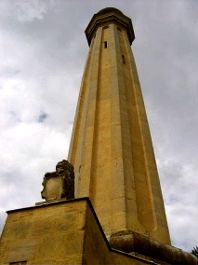
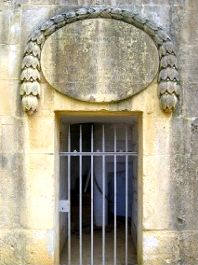
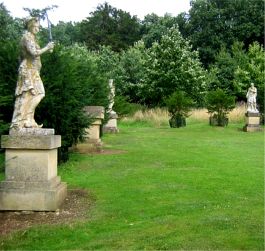
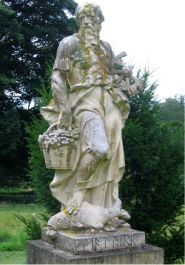 Following
the path, it curves away to the next feature, The Saxon Deities. This was a set
of seven carved Portland stone statutes on plinths representing the Saxon Gods who
gave their names to the seven days of the week (Sunna, Mona, Tiw, Woden, Thuner,
Friga and Seatern). Why have these statues in the garden? It was perhaps for the
belief that the Saxons brought liberal nations of government to Britain. These statues
have been moved here from their original location.
Following
the path, it curves away to the next feature, The Saxon Deities. This was a set
of seven carved Portland stone statutes on plinths representing the Saxon Gods who
gave their names to the seven days of the week (Sunna, Mona, Tiw, Woden, Thuner,
Friga and Seatern). Why have these statues in the garden? It was perhaps for the
belief that the Saxons brought liberal nations of government to Britain. These statues
have been moved here from their original location.
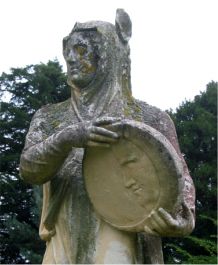
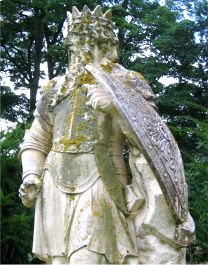
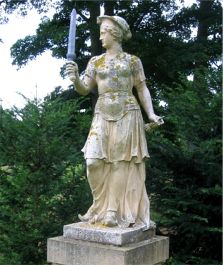
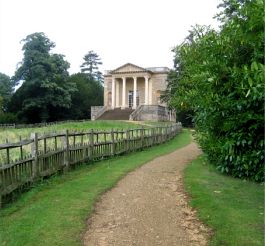
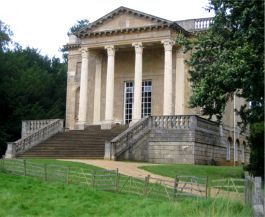 Next
temple to be found is 'Queen's Temple', probably the work of Gibbs and dating to
around 1742 to be started and completed some six years later. This Temple was devoted
to Ladies, the interior decorated with scenes of Ladies amusing themselves with
needlework, shells, painting and music. Of the original Gibbs building only the
rusticated base survives, the rest was remodelled, firstly in 1772-4 when the great
portico and steps were added and yet again in 1790 to commemorate the recovery of
King George III from madness having been nursed by Queen Charlotte to whom the Temple
was rededicated.
Next
temple to be found is 'Queen's Temple', probably the work of Gibbs and dating to
around 1742 to be started and completed some six years later. This Temple was devoted
to Ladies, the interior decorated with scenes of Ladies amusing themselves with
needlework, shells, painting and music. Of the original Gibbs building only the
rusticated base survives, the rest was remodelled, firstly in 1772-4 when the great
portico and steps were added and yet again in 1790 to commemorate the recovery of
King George III from madness having been nursed by Queen Charlotte to whom the Temple
was rededicated.
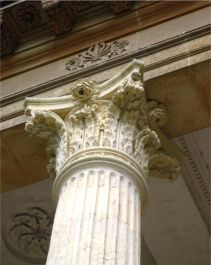
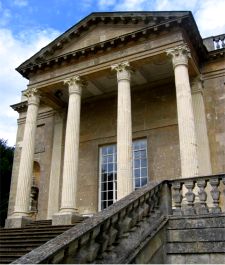
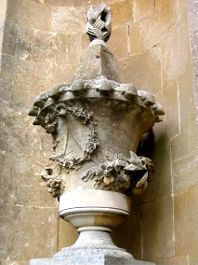
Tracing the path called 'Thanet Walk' I came upon 'The seasons Fountain', one of the last additions to the garden, thought to have been erected in honour of a visit by The Prince of Wales to the garden in 1805. Close inspection of this marble fountain shows it to have been constructed from a marble chimney piece. Originally the face of the fountain was enriched with Wedgwood blue and white plaques depicting the four seasons and silver drinking cups were suspended on chains.
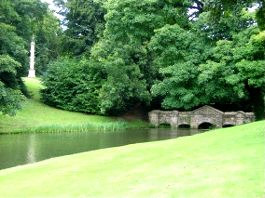
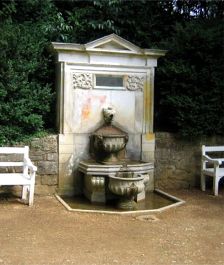

Walking on, along side the Alder River with a grotto cascade at its head, there are views of Captain Cook's monument of a globe on a plinth until I reached the 'Temple of British Worthies. This curved monument houses busts of British Worthies and was designed by William Kent in 1734-5. Busts are of two groups, those on the left are distinguished in the realm of ideas and those on the right are revered for their actions. On the left are such as Alexander Pope, Inigo Jones and William Shakespeare and to the right King Alfred, Elizabeth I and Sir Walter Ralegh.

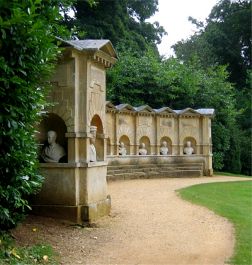
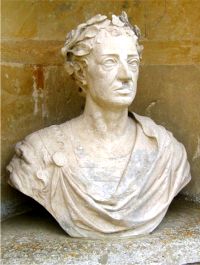
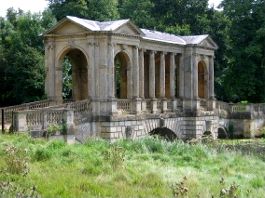
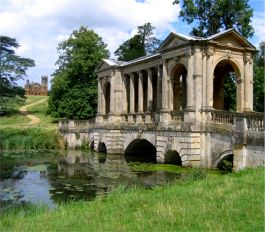 Continuing
my tour I come upon one of the most idyllic scenes of The Palladian Bridge across
the tranquil river. Its classical form beautifully reflected in the water. The idea
of the bridge was to take you across the river into the third division of the garden.
The bridge is the second of three almost identical bridges built in English gardens
between 1737-55, the other two at Wilton House, Wiltshire and Prior Park, Bath.
The bridge at Stowe was designed on the carriage route round the garden and thus
was the only one of the three built without steps.
Continuing
my tour I come upon one of the most idyllic scenes of The Palladian Bridge across
the tranquil river. Its classical form beautifully reflected in the water. The idea
of the bridge was to take you across the river into the third division of the garden.
The bridge is the second of three almost identical bridges built in English gardens
between 1737-55, the other two at Wilton House, Wiltshire and Prior Park, Bath.
The bridge at Stowe was designed on the carriage route round the garden and thus
was the only one of the three built without steps.
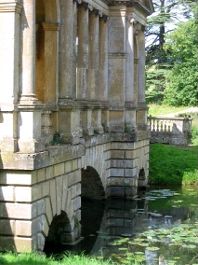
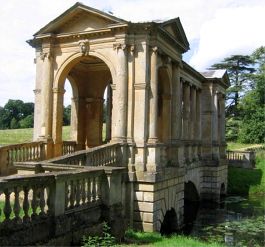
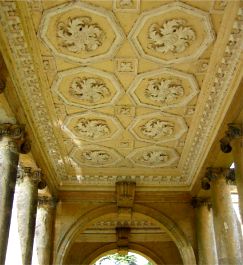
From the entrance to the bridge and looking away from it, there is on the hill the three sided Gothic Temple, this designed by Gibbs in 1741 and dedicated 'To the Liberties of our Ancestors'.
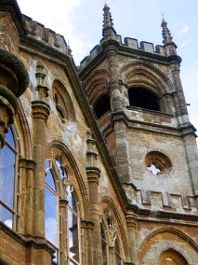
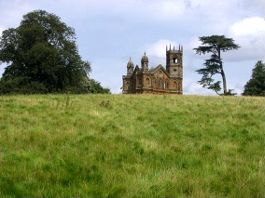
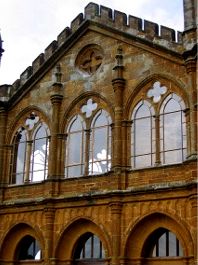
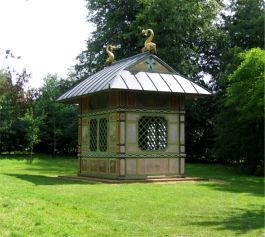
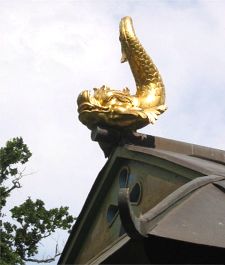 Crossing
the Palladian Bridge there is a path to the left that takes you to a clearing in
some trees where is an amazing 'Chinese House', quite different from all the stone
features that I had seen in the garden thus far. Constructed from wood and painted
canvas both inside and out with Chinese scenes the Chinese House originally floated
on the lake, but now stands on firm ground. The painted scenes are just charming
as are the two gilded carved wooden dolphins at each end of the roof.
Crossing
the Palladian Bridge there is a path to the left that takes you to a clearing in
some trees where is an amazing 'Chinese House', quite different from all the stone
features that I had seen in the garden thus far. Constructed from wood and painted
canvas both inside and out with Chinese scenes the Chinese House originally floated
on the lake, but now stands on firm ground. The painted scenes are just charming
as are the two gilded carved wooden dolphins at each end of the roof.

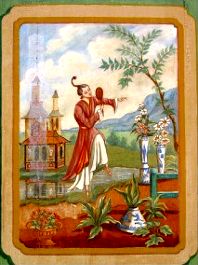
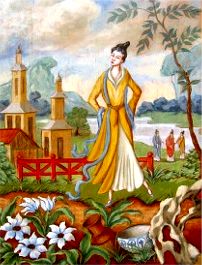
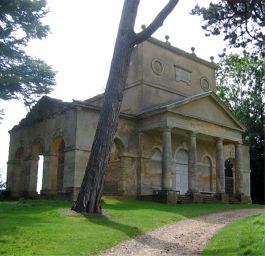
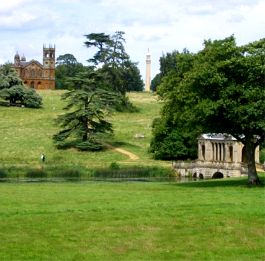 Continuing
the tour up the hill to the now ruined 'Temple of Friendship'. Built partly to commemorate
a visit to Stowe by Frederick, Prince of Wales in 1737 and partly for a 'particular
group of friends' for those Whigs who went into Opposition after the Excise Crisis
of 1733. They were known as 'Boy Patriots' or 'Cobham's Cubs'. The Temple faces
the Queen's Temple way across the valley in which Lady Cobham entertained her friends,
while her husband entertained his political friends in his 'Temple of Friendship'.
This Temple was one that was in regular use by Lord Cobham, it had in the basement
a kitchen and probably an ample wine cellar. Sadly it was destroyed to a ruin after
a fire here in the 1840's, but remains an important focal point in the garden scheme.
Continuing
the tour up the hill to the now ruined 'Temple of Friendship'. Built partly to commemorate
a visit to Stowe by Frederick, Prince of Wales in 1737 and partly for a 'particular
group of friends' for those Whigs who went into Opposition after the Excise Crisis
of 1733. They were known as 'Boy Patriots' or 'Cobham's Cubs'. The Temple faces
the Queen's Temple way across the valley in which Lady Cobham entertained her friends,
while her husband entertained his political friends in his 'Temple of Friendship'.
This Temple was one that was in regular use by Lord Cobham, it had in the basement
a kitchen and probably an ample wine cellar. Sadly it was destroyed to a ruin after
a fire here in the 1840's, but remains an important focal point in the garden scheme.
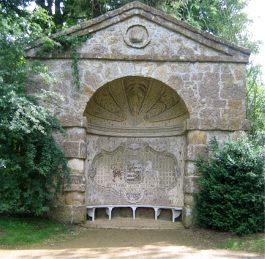
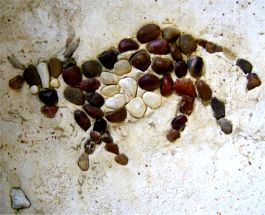
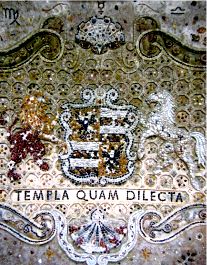
Walking on Westward along the Octagon Lake further temples to be admired include 'Pebble Alcove' looking out to 'Congreve's Monument' on a small Island and on to the Lake Pavilions. The 'Lake Pavilions', designed by Vanbrugh in 1719, provide a beautiful backdrop to the Octagon Lake when viewed from the house.
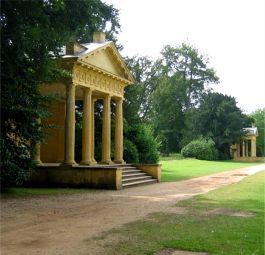
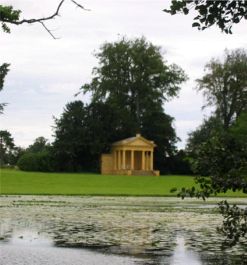
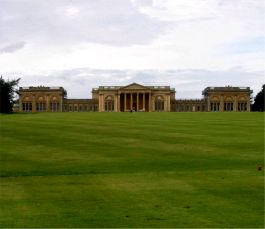
Continuing onwards, I travelled along the side of the 'Eleven Acre Lake' past the 'Hermitage' to the Temple of Venus which stands at the South end of the lake was one of the first features designed by William Kent for the new garden design. This Temple has a central block with pediment supported by columns and two side pavilions linked to the main block by arcaded quadrant walls. Parts of the Temple's decoration emphasised Venus's role in promoting sexual jealousy and strife.
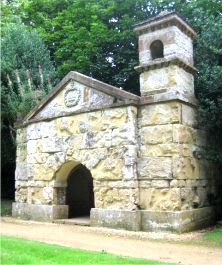
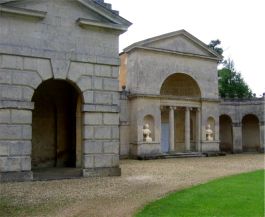
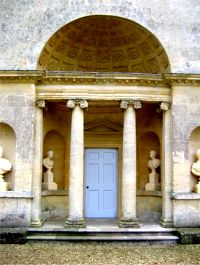
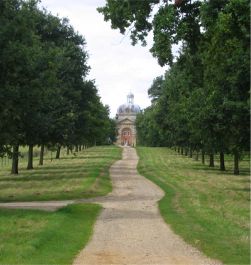
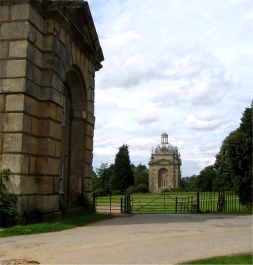 From
here a long straight driveway leads on to the 'Boycott Pavilions'. This pair of
pavilion's marked the entrance to the gardens from the park. They were linked in
the Eighteenth century with railings and central gates. From here I returned to
the house for a guided tour (which I covered last month), before continuing on to
do the second part of the garden walk. This second part of the walk first took me
to Captain Grenville's Column, an elegant column dedicated to Captain Thomas Grenville,
Royal Navy. He was one of Lord Cobham's nephews who was fatally wounded during a
battle with the French off Cape Finisterre. Then on to the 'Temple of Ancient Virtue',
a delightful circular colonnaded Temple with domed roof, completed in 1737 to a
design by Kent. Inside are four life size Portland Stone statues of Ancient Greeks
- Socrates, Homer, Lycurgus and Epaminondas. From the steps of this Temple are lovely
views across the Lake to the 'Monument of British Worthies'.
From
here a long straight driveway leads on to the 'Boycott Pavilions'. This pair of
pavilion's marked the entrance to the gardens from the park. They were linked in
the Eighteenth century with railings and central gates. From here I returned to
the house for a guided tour (which I covered last month), before continuing on to
do the second part of the garden walk. This second part of the walk first took me
to Captain Grenville's Column, an elegant column dedicated to Captain Thomas Grenville,
Royal Navy. He was one of Lord Cobham's nephews who was fatally wounded during a
battle with the French off Cape Finisterre. Then on to the 'Temple of Ancient Virtue',
a delightful circular colonnaded Temple with domed roof, completed in 1737 to a
design by Kent. Inside are four life size Portland Stone statues of Ancient Greeks
- Socrates, Homer, Lycurgus and Epaminondas. From the steps of this Temple are lovely
views across the Lake to the 'Monument of British Worthies'.
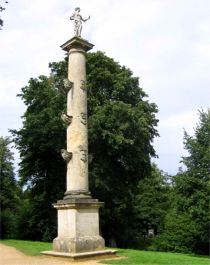
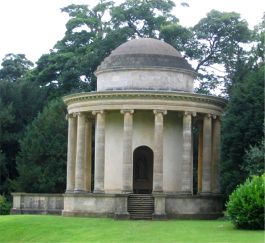
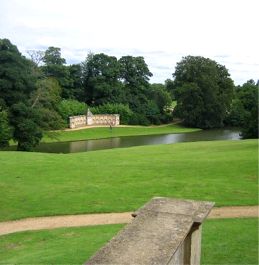
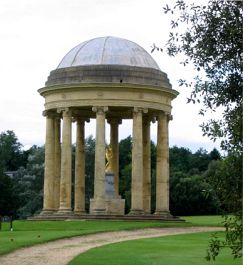
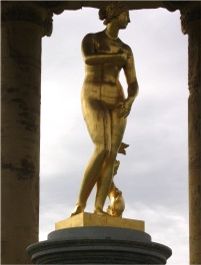 Passing
the 'Doric Arch' and Dido's Cave' I return towards the house via the final Temple
of my walk, 'The Rotunda'. The Rotunda was designed by Vanbrugh and built between
1720-1. Inside this beautifully graceful Temple is a gilded statue of the Venus
de' Medici, the 'Cyprian Queen' of West's poem. Not only was she the goddess of
love, but appropriately the patroness of gardening. This concludes my tour of this
magnificent garden. I hope that one day you are able to take a walk round these
immensely interesting gardens. A garden with so much interest - a garden for all
seasons.
Passing
the 'Doric Arch' and Dido's Cave' I return towards the house via the final Temple
of my walk, 'The Rotunda'. The Rotunda was designed by Vanbrugh and built between
1720-1. Inside this beautifully graceful Temple is a gilded statue of the Venus
de' Medici, the 'Cyprian Queen' of West's poem. Not only was she the goddess of
love, but appropriately the patroness of gardening. This concludes my tour of this
magnificent garden. I hope that one day you are able to take a walk round these
immensely interesting gardens. A garden with so much interest - a garden for all
seasons.
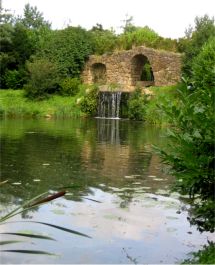
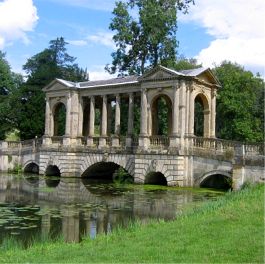
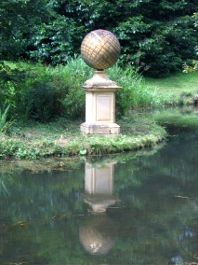
Stowe Landscape Garden,
Buckingham,
MK18 5DQ
Tel: +44 01280 822850
info line: +44 01494 755568
http://www.nationaltrust.org.uk
To review past newsletters, just follow this link:
Past newsletters.
To subscribe to this free newsletter -
Click here